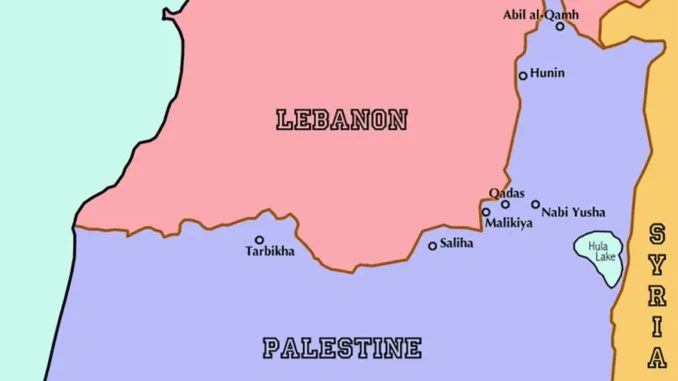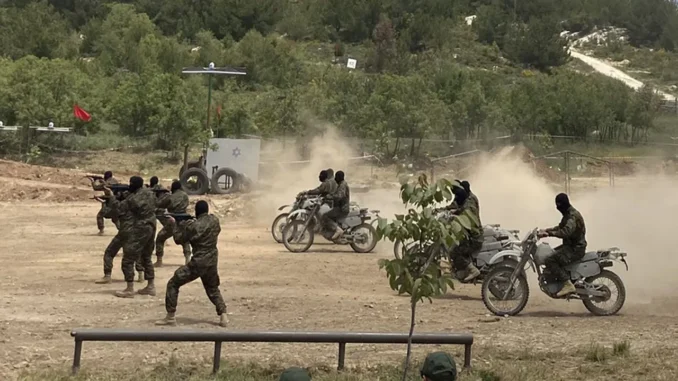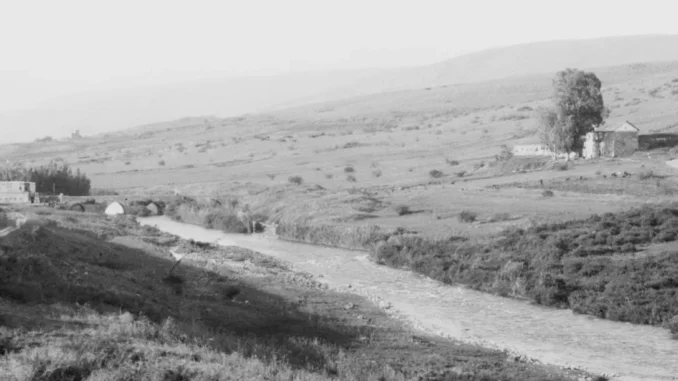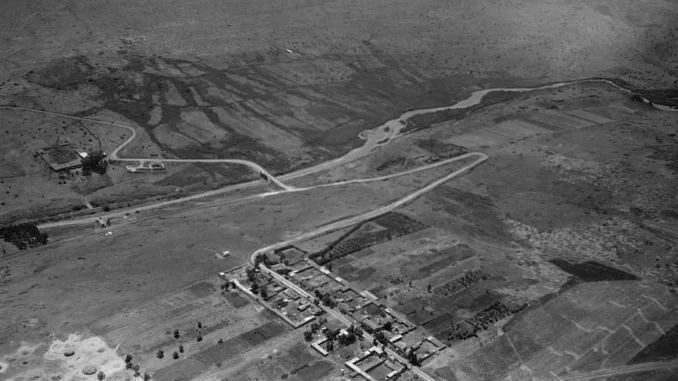By Col. (ret.) Jacques Neriah, JCPA 21 February 2024

This pre-1948 map showed the locations of seven Shiite villages inside the British Mandate for Palestine. (Zero0000/CC BY-SA 3.0 DEED)
On May 25, 2000, Israel withdrew its troops from its self-proclaimed security zone in South Lebanon under the pressure of Hizbullah’s guerrilla attrition warfare. Twenty-four years after the zone’s establishment, Israel decided that redeploying along its international border with Lebanon could potentially put an end to its military confrontation with Hizbullah, the Shiite Iranian-directed militia. Indeed, after consultation with the UN and in accordance with the agreed coordinates, Israel retreated to what is called the “Blue Line.”
The three places Israel decided not to withdraw from were the Rosh Hanikra tunnel crossing (registered as belonging to the state of Lebanon and recorded in the Lebanese land registrar under the file number 28/Naqoura), the Ghajar village, and the Shab’ah farms in the eastern part of the border between Israel and Lebanon. Israel claimed that these last two were not part of Lebanon since, according to the United Nations, cartographers, and historical research, they were part of southern Syria. They were conquered during the Six-Day War in June 1967.
Hizbullah, in concert with the Lebanese government, refused to recognize the Israeli claim.
However, Hizbullah did not put this issue high on its agenda and concentrated on planning an invasion of Israeli territory, a plan that was copied to the letter by Hamas in the Gaza Strip and applied on October 7, 2023. Note the Hizbullah motorcycle invasion tactic, pictured below, which was copied by Hamas fighters. Hizbullah chose to invest in preparations for confrontation with Israel and, inter alia, in digging attack tunnels that were to reach deep inside Israeli territory, tunnels which were uncovered by Israel in 2019 and sealed with tons of concrete.
 The general media was invited to observe Hizbullah’s war games exercises in southern Lebanon on May 21, 2023. (Hanna Davis, Twitter)
The general media was invited to observe Hizbullah’s war games exercises in southern Lebanon on May 21, 2023. (Hanna Davis, Twitter)
The issue of the seven villages resurfaced during the negotiations on the maritime border between Lebanon and Israel. Hizbullah presented itself as the protector of Lebanese interests and stressed the fact that there were 13 points of contention with Israel in which Israel had supposedly appropriated Lebanese territory. In the months that elapsed, Hizbullah’s rhetoric grew more aggressive towards Israel. It even went further by claiming that there was no reason to negotiate the delimitation of the land border since there was already an internationally recognized international border drawn in 1923.
In the course of the exchanges and especially following Hizbullah leaders’ declarations, it appeared that Hizbullah, emboldened by its unanswered provocations against Israel, raised another issue that was never put on focus in the past: Hizbullah claimed that not only did Ghajar and the Shab’ah farms belong to Lebanon and were under Israeli “occupation,” but, Israel had destroyed seven Shia villages in the northern part of the Galilee, whose residents had been deported or chased from their homes in the course of the 1948 war and never came back. Those seven villages had been initially part of Lebanon under the French mandate. In a later agreement between the mandatory powers, France and Great Britain, the villages were included in British-controlled mandatory Palestine, although their residents maintained their Lebanese citizenship.
 British and French frontier posts on the Galilee-Damascus highway in northern Galilee (Library of Congress, circa 1925)
British and French frontier posts on the Galilee-Damascus highway in northern Galilee (Library of Congress, circa 1925)
 The former French frontier post at the Jisr Benat Yacoub (Gesher B’not Yaakov) Jordan River crossing. A 1937 aerial view of the Galilee-Damascus Road showing British and French frontier posts. (Library of Congress)
The former French frontier post at the Jisr Benat Yacoub (Gesher B’not Yaakov) Jordan River crossing. A 1937 aerial view of the Galilee-Damascus Road showing British and French frontier posts. (Library of Congress)
According to Khalil Gemayel, a Lebanese general who was responsible for the southern Lebanese command, there were another 24 villages that were taken from Lebanon and attached to mandatory Palestine, but the residents did not carry a Lebanese ID, which is the reason why the Lebanese authorities and Hizbullah have mentioned only the seven villages.1
Indeed, following the 1949 armistice agreement between Lebanon and Israel, the Lebanese government accepted the demarcation of the borders between Lebanon and mandatory Palestine as drawn in 1923 (Paulet-Newcombe agreement on the delimitation of the border between Lebanon and Mandatory Palestine). Accordingly, Lebanon relinquished its claim to those seven villages, which remained under Israeli sovereignty.
A hundred years later, Hizbullah has positioned itself as the champion of those displaced residents and substituted itself for the Lebanese government; it has been demanding the restitution of those villages, even at the cost of a military confrontation with Israel.
What Are the Seven Villages?
- Hounine – today’s Margaliot
- Qadas – today’s Yiftah
- Al-Nabi Yosha’- today’s Metsoudat Koach /Metsoudat Yesha’
- Ibl el-Kamh – today’s Kfar Youval
- Tayr Bikha – today’s Shomera
- Salha – today’s Yir’on
- Al-Malekiyya – today’s Malkiyya
It is no coincidence that the attack tunnels dug by Hizbullah faced areas close or adjacent to those “seven villages” since Hizbullah’s proclaimed aim was to “liberate” the Galilee and to restore those areas “stolen by the Zionists” to Lebanese sovereignty.
****
Note
- Natasha Metni Torbey, En Israel, sept villages libanais annexes, ici Beyrouth, 16 Fevrier 2024, https://icibeyrouth.com/liban/315303??
Col. (ret.) Dr. Jacques Neriah



Leave a Reply
You must be logged in to post a comment.